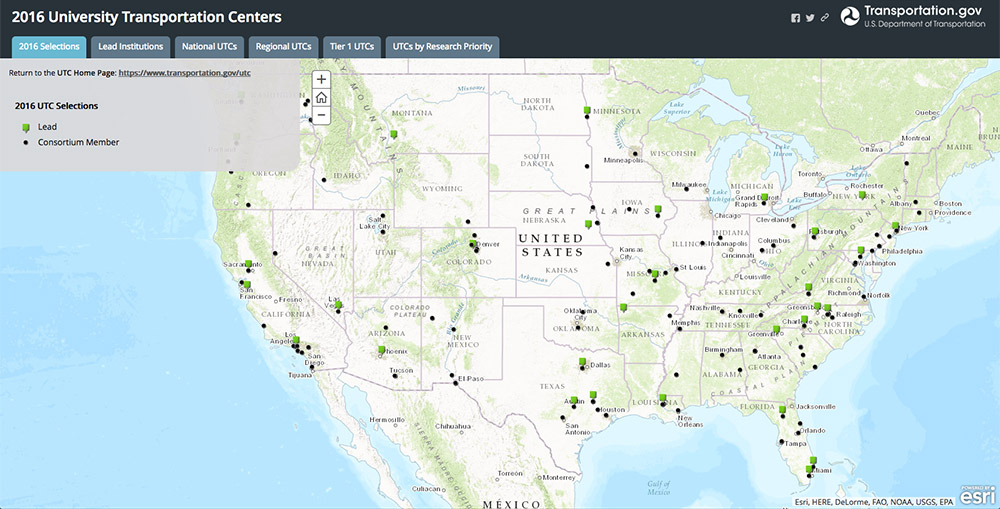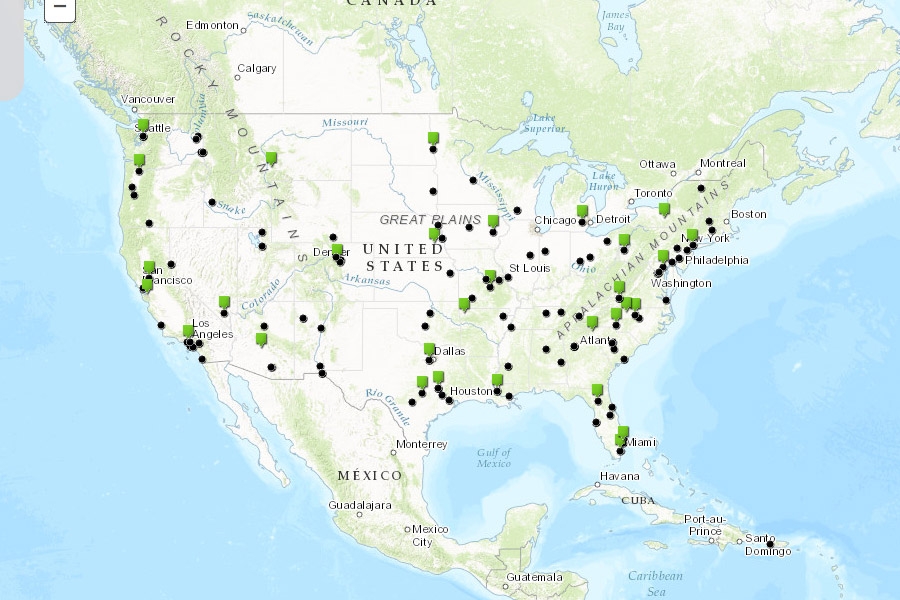 U.S. Department of Transportation map showing all of the newly funded University Transportation Centers and the affiliated universities. |
The U.S. Department of Transportation announced Dec. 5 it would invest $300 million in new research through University Transportation Centers, including half a dozen where the School of Civil and Environmental Engineering will play a significant role.
Those centers will focus on, among other things, congestion in the Southeast; transportation emissions’ relationship to energy use and public health; using robots and unmanned aerial vehicles for bridge inspections; and improving travel-behavior models by accounting for people’s attitudes.
|
UNIVERSITY TRANSPORTATION CENTERS |
|
|
Center for Advancing Research in Transportation Emissions, Energy and Health (CAR-TEEH) Focus: Understanding and modeling on-road transportation emissions and their implications on air pollution and human health, including the impact of new technologies on emissions and the effects of energy policy and air pollution regulations. |
|
|
Center for Transportation Equity, Decisions and Dollars |
|
|
Inspecting and Preserving Infrastructure through Robotic Exploration (INSPIRE) Focus: Developing an automated approach to field inspection and preservation of elevated structures like bridges using advanced autonomous systems with unmanned aerial vehicles and robotics. |
|
|
National Center for Sustainable Transportation Focus: Helping federal, state, regional, and local agencies improve energy efficiency and reduce emissions from passenger and freight travel. |
|
|
STRIDE: Southeastern Transportation Research, Innovation, Development and Education Center Focus: Reducing congestion across the Southeast with new strategies that use emerging technologies available in vehicles, telecommunications capabilities, and shared autonomy in transportation. |
|
|
Teaching Old Models New Tricks (TOMNET) Focus: Incorporating key elements of human decision-making — our perceptions, opinions, lifestyle choices, and personality traits — in regional transportation models. |
|
The Teaching Old Models New Tricks Center based at Arizona State University will tackle that last item, with the potential to vastly improve how transportation planners predict travelers’ reactions to new policies, trends and technologies.
“Currently, regional travel-behavior models include only ‘objective’ variables such as travel times, costs for various alternatives, and sociodemographic characteristics of the traveler,” said Patricia Mokhtarian, who will coordinate the research components of the new center. “They ignore key elements of human decision-making — our perceptions, opinions, lifestyle choices, and personality traits — and as a result, have only a limited ability to explain behavior.”
Mokhtarian said those models don’t do well with fast-moving societal trends or new technology that can heavily influence our travel choices.
“I'm extremely excited by this award, because it endorses the pursuit of ideas that I have been thinking about and discussing for some time — ideas that could lead to a marked change in the way we forecast regional travel demand,” said Mohktarian, the School’s Susan G. and Christopher D. Pappas Professor. “It will be exhilarating to be working with such brilliant minds to achieve a major breakthrough in the realism of the tools needed to inform the planners and policymakers of the future.”
“It is impressive to have faculty members in our School involved in so many of the successful transportation center proposals,” said Reginald DesRoches, the Karen and John Huff School Chair. “It is yet another example of the outstanding faculty that we have and how highly their work is regarded.”
DesRoches will serve as the Georgia Tech lead for another of the new research centers, Inspecting and Preserving Infrastructure through Robotic Exploration, or INSPIRE. Based at the Missouri University of Science and Technology, the center will explore using robots and UAVs for bridge inspections.
It’s an idea DesRoches said could save billions and revolutionize current practice by automating what is now a time-consuming and expensive manual inspection process.
“This is a unique project that brings together so many different areas — robotics, sensing technology, structural engineering, autonomous technologies, and hazard mitigation — with the goal of making our transportation network safer. This project has the potential to truly transform the way we assess our bridges.”
For the Center for Advancing Research in Transportation Emissions, Energy and Health, the goal is to bring together research in transportation and public health to address the impact of emissions. Michael Rodgers leads Georgia Tech’s work evaluating the effects of port-related emissions on human health.
“We are excited about this opportunity to combine the expertise of transportation and environmental professionals with those of health experts to better understand ways in which both transportation workers and the public, especially underrepresented communities, can be better protected,” Rodgers said.
Other projects include renewing funding for the National Center for Sustainable Transportation based at the University of California, Davis, which works to reduce emissions from passenger and freight travel. Randall Guensler leads Georgia Tech’s work with that center.
There’s also the Center for Transportation Equity, Decisions and Dollars at the University of Texas at Arlington, which involves Catherine Ross.
STRIDE: Southeastern Transportation Research, Innovation, Development and Education Center will continue to develop strategies to reduce regional traffic congestion using new vehicle-based technologies, telecommunications capabilities, and other strategies. Based at the University of Florida, Michael Hunter leads Georgia Tech’s work with the four-year-old center.
DOT’s charge to University Transportation Centers is to solve transportation challenges that “directly impact their communities and affect the efficiency of the nation’s transportation system.” The centers must focus on one of the six priorities laid out in federal transportation legislation: improving mobility of people and goods, reducing congestion, promoting safety, improving the durability and extending the life of transportation infrastructure, preserving the environment, or preserving the existing transportation system.
“Our nation faces unprecedented challenges from population growth, a changing climate, and increasing freight volumes,” said U.S. Transportation Secretary Anthony Foxx. “Universities are at the forefront of identifying solutions, researching critical emerging issues, and ensuring improved access to opportunity for all Americans.”

